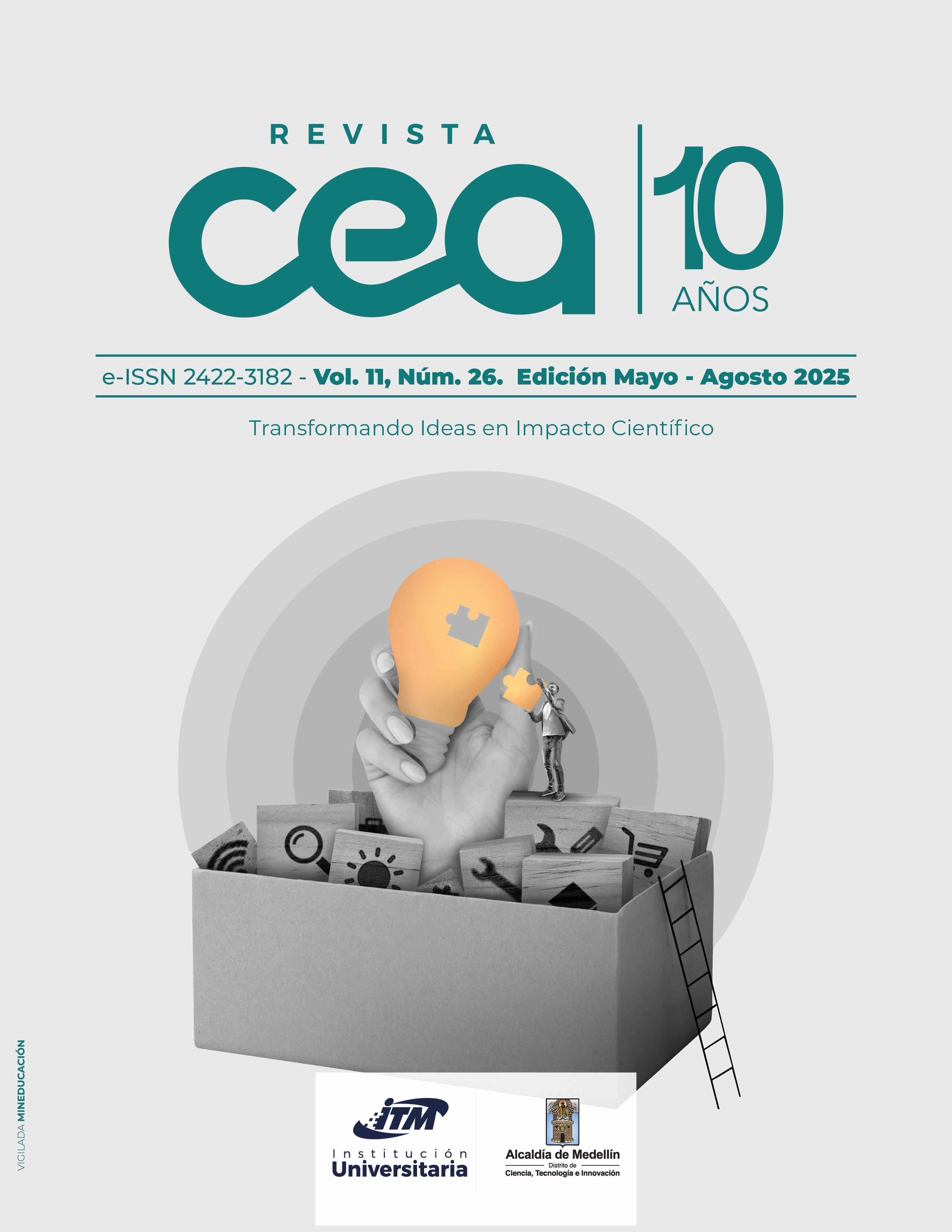El compromiso en las organizaciones: revisión sistemática y evolución teórica del concepto de la propensión instrumental al compromiso organizacional
Resumen
Objetivo: el objetivo de la presente revisión sistemática fue analizar la evolución teórica del constructo propensión instrumental al compromiso organizacional.
Diseño/Metodología: se realizó una revisión sistemática, basada en las directrices PRISMA, de los artículos académicos publicados entre 1958 y 2024 sobre el concepto de propensión instrumental al compromiso organizacional.
Resultados: fue posible distinguir dos etapas con respecto a su desarrollo teórico, a) etapa de costos, inversiones y sacrificios, de 1958 a 2024, que se basa en las expectativas sobre el costo-beneficio entre el individuo y la organización; y b) etapa de propensión instrumental al compromiso organizacional, de 1975 a 2014; el concepto evoluciona hacia la manifestación de una propensión o inclinación del individuo a comprometerse con su organización con base en el beneficio que representa quedarse laborando.
Conclusión: la evolución teórica de la propensión instrumental al compromiso organizacional revela un cambio desde un enfoque centrado en costos y sacrificios hacia uno basado en beneficios percibidos. Esta transición permite anticipar el compromiso desde etapas tempranas del empleo. El análisis aporta fundamentos para futuras escalas de medición y prácticas en gestión del talento.
Originalidad: este trabajo identifica dos etapas fundamentales en el desarrollo de la propensión instrumental al compromiso organizacional y permite reconocer las variables para medirlo en una etapa temprana de desarrollo.
Referencias bibliográficas
Aiswarya, B., y Ramasundaram, G. (2017). Factors Influencing The Continuance Commitment of Employees. Asian Journal of Management, 8(4), 1041–1050. https://doi.org/10.5958/2321-5763.2017.00160.3
Aktar, A., y Pangil, F. (2020). HRM practices, employee engagement, organisational commitment and work-related social support. Journal for Global Business Advancement, 13(6), 688-705. https://doi.org/10.1504/JGBA.2020.113131
Allen, N. J., y Meyer, J. P. (1990). The measurement and antecedents of affective, continuance and normative commitment to the organization. Journal of Occupational Psychology, 63(1), 1–18. https://doi.org/10.1111/j.2044-8325.1990.tb00506.x
Angle, H. L., y Lawson, M. B. (1993). Changes in affective and continuance commitment in times of relocation. Journal of Business Research, 26(1), 3–15. https://doi.org/10.1016/0148-2963(93)90039-R
Arias Galicia, F. (2001). El compromiso personal hacia la organización y la intención de permanencia: Algunos factores para su incremento. Contaduría y Administración, (200), 5–12. https://www.redalyc.org/pdf/395/Resumenes/Resumen_39520002_1.pdf
Bateman, T. S., y Strasser, S. (1984). A longitudinal analysis of the antecedents of organizational commitment. Academy of Management Journal. Academy of Management, 27(1), 95–112. https://www.jstor.org/stable/255959
Becker, B. E., y Huselid, M. A. (2006). Strategic human resources management: Where do we go from here? Journal of Management, 32(6), 898–925. https://doi.org/10.1177/0149206306293668
Becker, H. (1960). Notes on the concept of commitment. American Journal of Sociology, 66(1), 32–40. http://dx.doi.org/10.1086/222820
Blau, P. (1964). Exchange and power in social life. John Wiley & Sons, Inc.
Brown, R. B. (1996). Organizational commitment: Clarifying the concept and simplifying the existing construct typology. Journal of Vocational Behavior, 49(3), 230–251. https://doi.org/10.1006/jvbe.1996.0042
Carson, K. D., y Carson, P. P. (2002). Differential Relationships Associated with Two Distinct Dimensions of Continuance Commitment. International Journal of Organization Theory y Behavior (Marcel Dekker), 5(3/4), 359. https://doi.org/10.1081/OTB-120014896
Chigeda, F., Ndofirepi, T. M., y Steyn, R. (2022). Continuance in organizational commitment: The role of emotional intelligence, work-life balance support, and work-related stress. Global Business and Organizational Excellence, 42(1), 22–38. https://doi.org/10.1002/joe.22172
Cohen, A. (2007). Commitment before and after: An evaluation and reconceptualization of organizational commitment. Human Resource Management Review, 17(3), 336–354. https://doi.org/10.1016/j.hrmr.2007.05.001
Cramer, D. (1996). Job satisfaction and organizational continuance commitment : a two-wave panel study. Journal of Organizational Behavior, 17(4), 389–400. https://doi.org/10.1002/(SICI)1099-1379(199607)17:4<389::AID-JOB755>3.0.CO;2-2
Devassia, B. P., Janarthanam, S., y Muço, K. (2025). Employee retention analysis: Work integration strategy in business management institutions. Corporate & Business Strategy Review, 6(1), 112–118. https://doi.org/10.22495/cbsrv6i1art11
Elstad, B. (2003). Continuance commitment and reasons to quit: A study of volunteers at a jazz festival. Event Management, 8(2), 99–108. https://doi.org/10.3727/152599503108751757
Ernest, E. E., y Vincent, E. (2025). Employee Commitment and Organizational Performance of SMES in Delta State. International Research Journal of Multidisciplinary Scope, 6(1), 472-481. https://doi.org/10.47857/irjms.2025.v06i01.02233
Fantahun, B., Dellie, E., Worku, N., y Debie, A. (2023). Organizational commitment and associated factors among health professionals working in public hospitals of southwestern Oromia, Ethiopia. BMC Health Services Research, 23(180). https://doi.org/10.1186/s12913-023-09167-3
Ganzach, Y., Pazy, A., Ohayun, Y., y Brainin, E. (2002). Social exchange and organizational commitment: Decision-making training for job choice as an alternative to the realistic job preview. Personnel Psychology, 55(3), 613–637. https://doi.org/10.1111/j.1744-6570.2002.tb00123.x
Ghosh, S., y Swamy, D. (2014). A Literature Review on Organizational Commitment – A comprehensive summary. Journal of Engineering Research and Applications, 4(12), 04–14. https://www.ijera.com/papers/Vol4_issue12/Part%20-%201/B0412010414.pdf
Gilliland, D. I., y Bello, D. C. (2002). Two sides to attitudinal commitment : The effect of calculative and loyalty commitment on enforcement mechanisms in distribution channels. Academy of Marketing Science Journal, 30(1), 24. https://doi.org/10.1177%2F03079450094306
Han, H., Kiatkawsin, K., y Kim, W. (2019). Traveler loyalty and its antecedents in the hotel industry: Impact of continuance commitment. International Journal of Contemporary Hospitality Management, 31(1), 474–495. https://doi.org/10.1108/IJCHM-04-2017-0237
Han, E. J., y Cai, L. (2024). Impact of Psychological Capital on Organizational Commitment and Turnover Intention: Evidence from Korean Flight Attendants. Iranian Journal of Public Health, 53(7), 1578. https://doi.org/10.18502/ijph.v53i7.16052
Hrebiniak, L. G., y Alutto, A. J. (1972). Personal and role-related factors in the development of organizational commitment. Administrative Science Quarterly, 17(4), 555–573. https://doi.org/10.2307/2393833
Iverson, R. D., y Buttigieg, D. M. (1999). Affective, Normative and Continuance Commitment: Can the “Right Kind” of Commitment be Managed? Journal of Management Studies, 36(3), 307–333. https://doi.org/10.1111/1467-6486.00138
Jaros, S. J. (2012). Evaluating the “Few Alternatives” Dimension of Continuance Commitment : A Comment on Johnson, Chang, and Yang (2010). Journal of Leadership, Accountability y Ethics, 9(4), 63–71. http://www.na-businesspress.com/JLAE/JarosSJ_Web9_4_.pdf
Jaros, S., y Culpepper, R. A. (2014). An analysis of Meyer and Allen’s continuance commitment construct. Journal of Management and Organization, 20(1), 79–99. https://doi.org/10.1017/jmo.2014.21
Jiménez Hernández, R., Bustamante Valenzuela, G. E., y Bustamante Valenzuela, A. C. (2012). Compromiso organizacional: Una garantía para la subsistencia de las pequeñas y medianas empresas. Global Conference on Business and Finance Proceedings, 7(2), 1348–1351. https://core.ac.uk/download/pdf/76593459.pdf#page=1373
Johnson, R. E., y Chang, C. H. (2006). " I " is to continuance as " We " is to affective : the relevance of the self-concept for organizational commitment. Journal of Organizational Behavior, 27(5), 549–570. https://doi.org/10.1002/job.364
Kavaliauskiene, Z. (2012). Hierarchical dependence of antecedents of employee’s continuance commitment. Social Research, 1(26), 53–59. https://epublications.vu.lt/object/elaba:6100975/
Kavitha, S. R. (2025). The Impact of Human Resource Practices on Organizational Performance: The Mediating Role of Work Engagement. International Research Journal of Multidisciplinary Scope, 6(1), 213-225. https://doi.org/10.47857/irjms.2025.v06i01.02661
Ko, J. W., Price, J. L., y Mueller, C. W. (1997). Assessment of Meyer and Allen’s three-component model of organizational commitment in South Korea. Journal of Applied Psychology, 82(6), 961–973. https://doi.org/10.1037/0021-9010.82.6.961
Kothiyal, N. (2005). Three-Component Model of Organizational Commitment: Reexamination of Psychometric Properties of Continuance Commitment Scale. Indian Journal of Industrial Relations, 41(1), 117–130. https://www.jstor.org/stable/27767997
Lee, T. W., Ashford, S. J., Walsh, J. P., y Mowday, R. T. (1992). Commitment Propensity, Organizational Commitment, and Voluntary Turnover: A Longitudinal Study of Organizational Entry Processes. Journal of Management, 18(1), 15–32. https://doi.org/10.1177%2F014920639201800102
Liu, X., y Deng, J. (2011). Development of Organizational Commitment Based on the Social Exchange Theory [conferencia]. International Conference on Management and Service Science, Wuhan, China, 2011. https://doi.org/10.1109/ICMSS.2011.5997998
Marsh, R. M., y Mannari, H. (1977). Organizational commitment and turnover: A prediction study. Administrative Science Quarterly, 22(1), 57–75. https://doi.org/10.2307/2391746
Mathieu, J., y Zajac, D. (1990). A review and meta-analysis of the antecedents, correlates, and consequences of organizational commitment. Psychological Bulletin, 108(2), 171–194. https://doi.org/10.1037/0033-2909.108.2.171
McGee, G. W., y Ford, R. C. (1987). Two (or more?) dimensions of organizational commitment: Reexamination of the affective and continuance commitment scales. Journal of Applied Psychology, 72(4), 638–641. https://doi.org/10.1037/0021-9010.72.4.638
Meyer, J. P., y Allen, N. J. (1984). Testing the “side-bet theory” of organizational commitment: Some methodological considerations. Journal of Applied Psychology, 69(3), 372–378. https://doi.org/10.1037/0021-9010.69.3.372
Meyer, J. P., y Allen, N. j. (1987). A longitudinal analysis of the early development and consequences of organizational commitment. Canadian Journal of Behavioural Science / Revue Canadienne Des Sciences Du Comportement, 19(2), 199–215. https://doi.org/10.1037/h0080013
Meyer, J. P., y Allen, N. J. (1991). A three component conceptualization of organizational commitment. Human Resource Management Review, 1(1), 61–89. https://doi.org/10.1016/1053-4822(91)90011-Z
Meyer, J. P., Allen, N. J., y Gellatly, I. R. (1990). Affective and continuance commitment to the organization: Evaluation of measures and analysis of concurrent and time-lagged relations. Journal of Applied Psychology, 75(6), 710–720. https://doi.org/10.1037/0021-9010.75.6.710
Meyer, J. P., Bobocel, D. R., y Allen, N. J. (1991). Development of Organizational Commitment During the First Year of Employment: A Longitudinal Study of Pre- and Post-Entry Influences. Journal of Management, 17(4), 716. https://doi.org/10.1177%2F014920639101700406
Meyer, J. P., Stanley, L. J., y Parfyonova, N. M. (2012). Employee commitment in context: The nature and implication of commitment profiles. Journal of Vocational Behavior, 80(1), 1–16. https://doi.org/10.1016/j.jvb.2011.07.002
Nangoli, S., Kemboi, A., Lagat, C., Namono, R., Nakyeyune, S., y Muhumuza, B. (2021). Strategising for continuance commitment: the role of servant leadership behaviour. World Journal of Entrepreneurship, Management and Sustainable Development, 17(1), 51–61. https://www.emerald.com/insight/content/doi/10.1108/wjemsd-01-2020-0008/full/html
Nouri, H., y Kyj, L. (2014). An experimental examination of the combined effects of normative and instrumental commitments on budgetary slack creation: Comparing individuals versus group members. Advances in Management Accounting., 22, 225–260. https://doi.org/10.1108/S1474-7871(2013)0000022014
Nguyen, V. T., y Nguyen, T. K. (2021). Factors affecting organizational commitment: An empirical study of information technology sector in Vietnam. The Journal of Asian Finance, Economics and Business, 8(11), 277-284. https://doi.org/10.13106/jafeb.2021.vol8.no11.0277
Park, S. M., y Rainey, H. G. (2007). Antecedents, Mediators, and Consequences of Affective, Normative, and Continuance Commitment: Empirical Tests of Commitment Effects in Federal Agencies. Review of Public Personnel Administration, 27(3), 197-226. https://doi.org/10.1177/0734371X06296866
Pierce, J. L., y Dunham, R. B. (1987). Organizational Commitmen: Pre-Emplyment Propensity and Initial Work Experiences. Journal of Management, 13(1), 163–178. https://doi.org/10.1177/014920638701300113
Powell, D. M., y Meyer, J. P. (2004). Side-bet theory and the three-component model of organizational commitment. Journal of Vocational Behavior, 65(1), 157–177. https://doi.org/10.1016/S0001-8791(03)00050-2
Randall, D. M. (1993). Cross-cultural research on organizational commitment: A review and application of Hofstede’s value survey module. Journal of Business Research, 26(1), 91–110. https://doi.org/10.1016/0148-2963(93)90045-Q
Ratnasahara, E. D., Yuliastanti, R., Suyono, J., Chauhan, R., y Thakar, I. (2021). Affective Commitment, Continuance Commitment, Normative Commitment, and Turnover Intention in Shoes Industry. Annals of the Romanian Society for Cell Biology, 25(3), 1937–1945. http://annalsofrscb.ro/index.php/journal/article/view/1640
Rego, A., Leitte, R., Carvalho, T., Freire, C., y Vieira, A. (2004). Organizational commitment: Toward a different understanding of the ways people feel attached to their organizations. Management Research: Journal of the Iberoamerican Academy of Management, 2(3), 201–218. https://doi.org/10.1108/15365430480000510
Ritzer, G., y Trice, H. M. (1969). An empirical study of Howard Becker’s Side-Bet Theory. Social Forces, 47(4), 475–478. https://doi.org/https://doi.org/10.2307/2574537
Rodrigues, A. C. de A., Bastos, A. V. B., y Moscon, D. C. B. (2019). Delimiting the concept of organizational commitment: empirical evidence of the overlap between the entrenchment and the continuance mindset. Organizações y Sociedade, 26(89), 338–358. https://doi.org/10.1590/1984-9260897
Rusu, R. (2013). Affective Organizational Commitment, Continuance Organizational Commitment, or Normative Organizational Commitment? Academiei Fortelor Terestre, 2(70), 192–197.
Safari, H., Cabrita, M. d. R., Hesan, M., Maleki, M., y Mirzaeirabore, F. (2018). Ranking new comers to work based on commitment propensity through hybrid method of AHP and TOPSIS. Management and Production Engineering Review, 9(4), 86–95. https://doi.org/10.24425/119549
Sallan, J. M., Simo, P., Fernandez, V., y Enache, M. (2010). Estudio de la relación entre el compromiso organizativo y la intención de abandonar la organización: Modelo de dos componentes de compromiso de continuidad. Cuadernos de Gestión, 10(2), 15–28. https://doi.org/10.5295/cdg.090151js
Sam-Mensah, R., Bingab, B. B., Boakye, K. O., y Boateng, R. K. (2025). Safety first, retention forever: enhancing commitment and reducing turnover through safety practices. Future Business Journal, 11(1), 52. https://doi.org/10.1186/s43093-025-00475-0
San-Martín, S., Jiménez, N., Rodríguez-Torrico, P., y Piñeiro-Ibarra, I. (2020). The determinants of teachers’ continuance commitment to e-learning in higher education. Education and Information Technologies, 25(4), 3205–3225. https://doi.org/10.1007/s10639-020-10117-3
Shore, L. M., y Wayne, S. (1993). Commitment and employee behavior: Comparison of affective commitment and continuance commitment with perceived organizational support. Journal of Applied Psychology, 78(5), 774–780. https://doi.org/10.1037/0021-9010.78.5.774
Somers, M. J. (2009). The combined influence of affective, continuance and normative commitment on employee withdrawal. Journal of Vocational Behavior, 74(1), 75–81. https://doi.org/10.1016/j.jvb.2008.10.006
Stumpf, S. A., y Hartman, K. (1984). Individual Exploration to Organizational Commitment or Withdrawal. Academy of Management Journal, 27(2), 308–329. https://psycnet.apa.org/record/1984-27461-001
Suliman, A., y Iles, P. (2000). Is continuance commitment beneficial to organizations? Commitment-performance relationship: a new look. Journal of Managerial Psychology, 15(5), 407–422. https://doi.org/10.1108/02683940010337158
Swailes, S. (2002). Organizational Commitment: A Critique of the Construct and Measures. International Journal of Management Reviews, 4(2), 155–178. https://doi.org/10.1111/1468-2370.00082
Taing, M. U., Granger, B. P., Groff, K. W., Jackson, E. M., y Johnson, R. E. (2011). The Multidimensional Nature of Continuance Commitment: Commitment Owing to Economic Exchanges Versus Lack of Employment Alternatives. Journal of Business and Psychology, 26(3), 269–284. https://doi.org/10.1007/s10869-010-9188-z
Thi Bi Chi, H., y Hanh, L. N. (2016). Affective and Instrumental Commitment: A Special Reference to Self-Service Technologies in Domestic and Foreign Banks. Journal of Economic Development, 23(2), 137–160. https://vjol.info.vn/index.php/ed/article/view/34117
Urrútia, G., y Bonfill, X. (2010). Declaración PRISMA: una propuesta para mejorar la publicación de revisiones sistemáticas y metaanálisis. Medicina Clínica, 135(11), 507–511. https://doi.org/10.1016/j.medcli.2010.01.015
Vandenberg, R. J., y Self, R. M. (1993). Assessing Newcomers’ Changing Commitments to the Organization During the First 6 Months of Work. Journal of Applied Psychology, 78(4), 557–568. https://doi.org/10.1037/0021-9010.78.4.557
Vandenberghe, C., y Panaccio, A. (2012). Perceived sacrifice and few alternatives commitments: The motivational underpinnings of continuance commitment’s subdimensions. Journal of Vocational Behavior, 81(1), 59–72. https://doi.org/10.1016/j.jvb.2012.05.002
Wang, C. L., Indridason, T., y Saunders, M. N. K. (2010). Affective and continuance commitment in public private partnership. Employee Relations, 32(4), 396–417. https://doi.org/10.1108/01425451011051613
Wasti, S. A. (2002). Affective and continuance commitment to the organization: Test of an integrated model in the Turkish context. International Journal of Intercultural Relations, 26(5), 525–550. https://doi.org/10.1016/S0147-1767(02)00032-9
Wasti, S. A. (2005). Commitment profiles: Combinations of organizational commitment forms and job outcomes. Journal of Vocational Behavior, 67(2), 290–308. https://doi.org/10.1016/j.jvb.2004.07.002
Weibo, Z., Kaur, S., y Jun, W. (2010). New development of organizational commitment: A critical review (1960 - 2009). African Journal of Business Management, 4(1), 12–20. https://academicjournals.org/article/article1380698607_WeiBo%20et%20al.pdf
Werbel, J., Landau, J., y DeCarlo, T. E. (1996). The Relationship of Pre-entry Variables to Early Employment Organizational Commitment. Journal of Personal Selling y Sales Management, 16(2), 25–36. https://doi.org/10.1080/08853134.1996.10754051
Whitener, E. M., y Walz, P. M. (1993). Exchange Theory Determinants of Affective and Continuance Commitment and Turnover. Journal of Vocational Behavior, 42(3), 265–281. https://doi.org/10.1006/jvbe.1993.1019
Wiener, Y., y Vardi, Y. (1980). Relationships between job, organization, and career commitments and work outcomes—An integrative approach. Organizational Behavior and Human Performance, 26(1), 81–96. https://doi.org/10.1016/0030-5073(80)90048-3
Yücel, İ., Gomes, D. R., Ribeiro, N., y Özlok, K. K. (2024). The Mediating Role of Self-Esteem in the Relationship Between Perceived Ethnic Discrimination and Continuance Commitment of Migrant Workers. Psychological Reports. https://doi.org/10.1177/00332941241226686
Descargas
Derechos de autor 2025 Mariana Ivonne Nava Soto, Emmanuel Francisco García Uribe, Patricia Ramos Rubio

Esta obra está bajo una licencia internacional Creative Commons Atribución-NoComercial-CompartirIgual 4.0.

| Estadísticas de artículo | |
|---|---|
| Vistas de resúmenes | |
| Vistas de PDF | |
| Descargas de PDF | |
| Vistas de HTML | |
| Otras vistas | |







